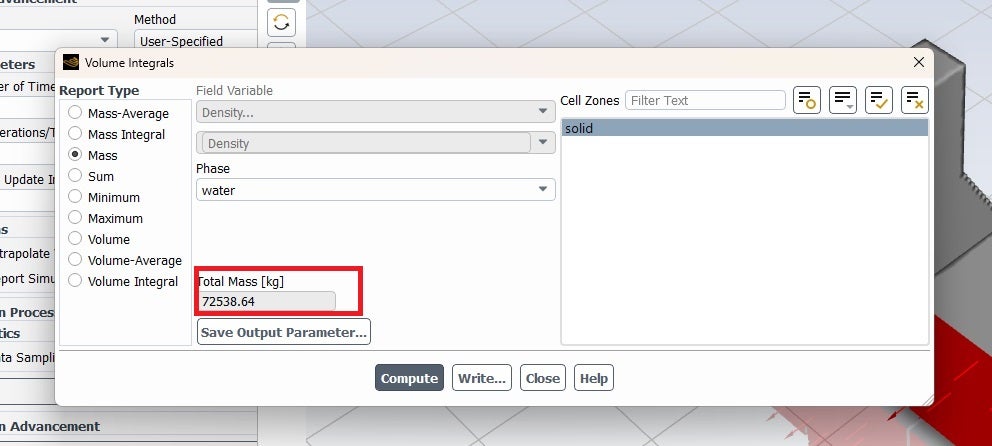-
-
December 8, 2022 at 10:57 am
abhnv11295
SubscriberWith my two phase VOF simulation for a closed domain, I observed that I am loosing mass.
Mesh is refined and time step is of the order of 0.0001 sec.
What can be the reason for loss of mass in the system.
-
December 8, 2022 at 12:14 pm
Rob
Forum ModeratorConvergence and mesh resolution would be the first things to check. Are both phases fixed density?
-
December 8, 2022 at 12:21 pm
abhnv11295
SubscriberLiquid phase - Function of temperature
Vapor phase - Ideal gas
Convergence criteria:
Continuity - 1e-05
Velocity - 1e-04
Energy - 1e-07
-
December 8, 2022 at 2:26 pm
Rob
Forum ModeratorAnd the mesh resolution?
-
December 9, 2022 at 4:36 am
-
December 9, 2022 at 4:38 am
abhnv11295
SubscriberMy Mesh quality
1. Avg Element quality – 0.9977
2. Avg Aspect ratio – 1.0419
3. Avg Skewness – 0.001083
-
December 9, 2022 at 10:02 am
Rob
Forum ModeratorIf you're wanting to model VOF phase change, ie you need to track the bubbles use a lot more cells. You're looking at putting 5-10 cells across each bubble, or the film if it's surface boiling.
-
December 9, 2022 at 10:25 am
abhnv11295
SubscriberBut, using a lot more cells will also increase my computational time.
Except the cell resolution, can there be any other reason for loss of mass inside the system?
-
December 9, 2022 at 11:56 am
Rob
Forum ModeratorUsing more cells will cost compute and time, yes, but without running a finer mesh you won't know if the results are mesh dependent.
Accuracy is likely reason for mass loss. Whether that's convergence, cell resolution or solver related is a different question, and you'd need to run more models to change solver mesh & parameters to figure that out.
-
December 9, 2022 at 12:06 pm
abhnv11295
SubscriberShould we say that with accurate and correct model one can get zero mass loss/gain?
Or zero mass loss/gain for a closed domain is an ideal case?
-
December 9, 2022 at 1:32 pm
Rob
Forum ModeratorIn an ideal case all mass is conserved. In most cases some mass is lost eventually, but if the domain is well resolved spacially and with time the loss should be negligable.
-
December 9, 2022 at 1:44 pm
abhnv11295
SubscriberWith time step of 0.0001 sec(e-04) and after running 600,000 timesteps (=60sec), mass lost is approximately 0.3%, can this be considered negligible or the value is significant?
-
December 9, 2022 at 1:48 pm
Rob
Forum ModeratorI'd consider it negligable, but you're the one deciding that based on your work. You also need to see if it's 0.3% mass liquid or vapour, and how that impacts the domain volume.
-
December 9, 2022 at 2:36 pm
abhnv11295
SubscriberThanks Rob for your help.
Highly appreciate it.
-
November 21, 2023 at 3:42 am
walaakm10
SubscriberHello, I wonder, how can check the mass loss on my model.
-
November 21, 2023 at 10:22 am
Rob
Forum ModeratorVolume integrals, and then report the mass of a phase/species to a monitor plot.
-
November 21, 2023 at 10:54 am
-
November 21, 2023 at 11:32 am
Rob
Forum ModeratorI don't know what you've set up so can't comment.
-
November 22, 2023 at 5:19 am
walaakm10
Subscriberok, I got it. But could you please just give me a description of what this number represents? this one I got from "Volume integrals<< mass of a phase"water"?
Is it equivalent to the mass of water in the system/model after the simulation?
-
November 22, 2023 at 11:56 am
Rob
Forum ModeratorIt's the mass of water in the domain at the instant you ran the report.
-
November 22, 2023 at 12:15 pm
walaakm10
Subscribermany thanks
-
November 25, 2023 at 11:05 am
walaakm10
Subscriberwould someone help me in evaluating the mass loss? I mean, how much the mass loss could be accepted? I got 30%, is this acceptable?
-
November 28, 2023 at 1:59 pm
Rob
Forum Moderator30% seems very high, so convergence may not be good. You need to review the post processing to see what's going on, and whether mass is lost due real flow patterns or poor convergence.
-
- The topic ‘Loss of mass in a closed domain.’ is closed to new replies.



-
3402
-
1057
-
1051
-
896
-
877

© 2025 Copyright ANSYS, Inc. All rights reserved.

.png)







